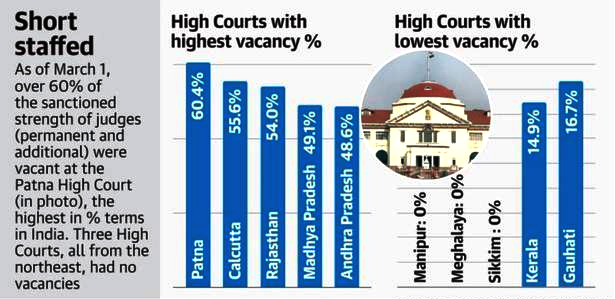[ad_1]

Introduction:
Nearly 150 years ago, A.V. Dicey, the foremost constitutional lawyer of his day, wrote, “The essential characteristic of federalism is the distribution of limited executive, legislative and judicial authority among bodies which are coordinate with and independent of each other”.
Much has been written about the federal structure in relation to the legislature and the executive. We now examine the Indian judiciary and the need to strengthen the federal nature of our judiciary.
India is a union of States. The Supreme Court of India has held that the federalist nature of our country is part and parcel of the basic structure of the Constitution.
Integrated but Robust federal judicial system:
- Federalism is a midpoint between unitarism which has a supreme centre, to which the States are subordinate, and confederalism wherein the States are supreme, and are merely coordinated by a weak centre.
- The idea which lies at the bottom of federalism is that each of the separate States should have approximately equal political rights and thereby be able to maintain their non-dependent (for want of a better word) characteristics within the larger union.
- An integral requirement of a federal state is that there be a robust federal judicial system which interprets this constitution, and therefore adjudicates upon the rights of the federal units and the central unit, and between the citizen and these units.
- The federal judicial system comprises the Supreme Court and the High Court in the sense that it is only these two courts which can adjudicate the above rights.
- The Supreme Court was created under the Constitution, and is a relatively new court.
- On the other hand, some of the High Courts in our country have been in existence since the 1860s (and some existed even before that, in their earlier avatars as supreme courts of the Presidencies).
An equality of power of High courts and Supreme courts:
- The Indian Constitution envisaged the equality of power of High Court judges and Supreme Court judges, with a High Court judge not being a subordinate of a Supreme Court judge.
- The Supreme Court has, on many occasions, reiterated the position that the Supreme Court is superior to the High Court only in the appellate sense.
- Therefore, the theoretical position has always been that High Court judges and Supreme Court judges are equals.
- A delicate balance is required to be maintained between the Supreme Court and the High Courts in order for the constitutional structure dreamt of by B.R. Ambedkar to work.
- This balance existed from Independence onwards, until the 1990s. Since then, however, it has been tilting in favour of the central court.
- The need for this balance was underscored during the Emergency, when the High Courts (a significant number, at least) stood out as beacons of freedom, even as the Supreme Court failed in this duty.
- In recent years, three specific trends have greatly eroded the standing of the High Court, leading to an imbalance in the federal structure of the judiciary.
- First, the Supreme Court (or rather, a section of its judges, called “the Collegium”) has the power to appoint judges and chief justices to the High Courts and the Supreme Court.
- This Collegium also has the power to transfer judges and chief justices from one High Court to another.
- Second, successive governments have passed laws that create parallel judicial systems of courts and tribunals which provide for direct appeals to the Supreme Court, bypassing the High Courts.
- Third, the Supreme Court has been liberal in entertaining cases pertaining to trifling matters.
- First, the Supreme Court (or rather, a section of its judges, called “the Collegium”) has the power to appoint judges and chief justices to the High Courts and the Supreme Court.
Parallel judicial hierarchies:
- The another important factor identified is the creation of parallel hierarchies of courts and tribunals, whether it be the Competition Commission, or the company law tribunals, or the consumer courts.
- In all these cases, the High Courts are bypassed. Laws have been drafted such that the High Court has no role to play and the Supreme Court directly acts as an appellate court.
- But in reality, the weakening of the state units sets off a weakening of the entire body of the state, which gradually ossifies into irreversible decay.
- B.R. Ambedkar stated in the Constituent Assembly: “The Indian Federation though a dual polity has no dual judiciary at all.
- The High Courts and the Supreme Court form one single integrated judiciary having jurisdiction and providing remedies in all cases arising under the constitutional law, the civil law or the criminal law.”
Streamlining the Appointment System: The vacancies must be filled without any unnecessary delay.
A proper time frame for the appointment of judges must be laid down and the recommendations must be given in advance.
The Constitution of the All India Judicial Services is also an important factor which can definitely help India establish a better judicial system.
Conclusion:
The Supreme Court should do itself recognizes the importance of self-abnegation and restores the federal balance by re-empowering the High Courts. This will be in the best interest of the nation.
Federalism is a midpoint between unitarism which has a supreme centre, to which the States are subordinate, and confederalism wherein the States are supreme, and are merely coordinated by a weak centre.
An integral requirement of a federal state is that there be a robust federal judicial system which interprets the constitution
The federal judicial system comprises the Supreme Court and the High Court in the sense that it is only these two courts which can adjudicate the above rights.
[ad_2]

